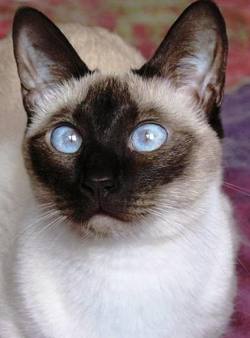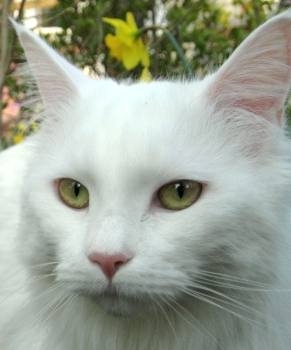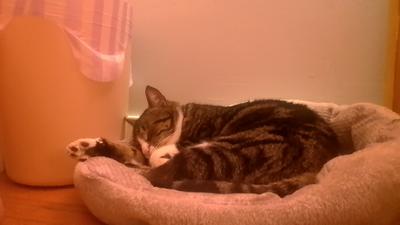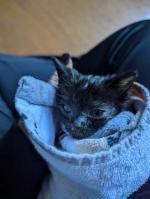Cat Breeds: A Guide for Cat Lovers
Many cat breeds have been developed over the years, as people try to shape the personality, looks, and physical resilience of the amazing creature known as the cat.
Each of the domestic breeds has its own appeal, and they each have their fans.
Some will defend with all of their strength the reasons why a Siamese is "better" than a Ragdoll, or an active Cornish Rex is "better" than a laid back Persian.
The feline form takes many shapes, sizes, and color variations, even within the same species.
No type of cat has more variation, however, than that of the domestic cat, or house cat.
Why? Because people had a hand in it, of course!
For about 2,000 years, people have been "creating" different breeds. As time has gone on, existing breeds have been refined to bring out certainly qualities considered desirable.
The development of modern style cat shows and the Cat Fancy in the late 1800s accelerated this process, as competition will do.
Even today, new breeds are being developed. Some are relatively rare breeds. Old breeds are being further refined, and in some cases, mixed with wild cats to form yet another breed (commonly known as hybrids).
In addition, people have transported cats to places far from their original homelands. In some cases, these cats adapted over time to hot sun, or harsh winters that they weren't used to in their native lands. This has brought further changes to the physical nature and appearance of certain breeds.

Below you will find a growing list of links to articles on choosing different breeds: from Abyssinian and Burmese, to Siamese to Turkish Van and more.
Pay close attention to personality traits of each breed and how your future cat might fit into your lifestyle and your household.
Every cat is an individual, that's for sure, but you may be able to get a general idea of what the breed is like.
If you are looking for just the right feline companion for you, you may find it in the description on one of these pages.
You may want to start by looking at the most popular breeds or with this breed list page.
Discuss any and all breeds of cat here.
Photo credit: Siamese cat by Seamus Kearney (Seamus Kearney, uploader of the image, own work) [CC BY-SA 3.0], via Wikimedia Commons
Have A Picture To Add To The Gallery?
Would you like to share a picture of a cat of a particular breed with us? You can. It's easy. First, enter a description and a story about the picture. Enter some basic information, such as the name of the cat in the photo, and anything else you'd like us to know.
Important! Make sure you tell us what breed the cat is, and include the coat color and pattern. You can also tell us when the pic was taken and where, how old the cat is, or something interesting about the cat as well. People love to read cat stories! Then, upload the picture below.
Cat Breeds
Below are the cat breed information pages. As I've said, every cat is an individual, but the cat breed info below is a great starting point when determining what type of cat to adopt.
- Abyssinian
The Abyssinian Cat is affectionate and loyal. - American Bobtail cat
The American Bobtail is a wild looking but friendly cat. More about the American Bobtail and its history. - American Curl
The American Curl is a unique looking cat. - American Shorthair
The American Shorthair is not just an alley cat! - American Wirehair
The American Wirehair is a barn cat turned champion. - Balinese
The Balinese began as a Siamese longhair. - Birman cat
The Birman cat breed has both Siamese and Persian ancestry. - Bombay
Ever wanted to live with a miniature panther? The Bombay cat breed looks like a wild black panther. - British Shorthair
The British Shorthair is a laid back cat, but not cuddly. - Burmese cat
The Burmese Cat is a quieter cousin to the noisy Siamese. - Burmilla Cat
- Chartreux The Chartreux cat breed is a sweet, interactive, quick learner.
- Colorpoint Shorthair
The Colorpoint Shorthair is an allergy friendly active cat. - Cornish Rex
The Cornish Rex is sociable, playful, and allergy friendly. - Devon Rex
The Devon Rex is a playful cuddler. - Egyptian Mau
The Egyptian Mau is an ancient breed for modern times. - European Burmese
The European Burmese is a lap loving breed. - Exotic cat
The Exotic cat is a like a Persian for lazy people. - Foreign White
The Foreign White cat breed is essentially a white colored unpointed variant of the Siamese. - Havana Brown
The Havana Brown is a big treat in a small package. - Japanese Bobtail
The rare Japanese Bobtail.More about the history and folklore surrounding Japanese Bobtail cats. - Javanese
The Javanese is a lap cat. - Korat
The lucky Korat cat breed (known as the Si-Sawat in its native Thailand). - LaPerm
The unique and intelligent LaPerm. - Maine Coon Cat
The large and intelligent Maine Coon Cat.The charm of the big Maine Coon cat. - Manx Cat
The Manx cat is a quiet but playful treat. - Norwegian Forest Cat
The beautiful Norwegian Forest Cat. - Ocicat
The wild looking but very tame ocicat. - Persian cat
The gentle and beautiful Persian has a luxurious long coat. - Pixie Bob Cats
Pixie Bob Cats are smart, wild looking, and loving. - Raggamufin
The ragamuffin is a large, lovable cat that is very tolerant of children and other pets. - Ragdoll cat
The Ragdoll is the ultimate lap cat. Ragdoll cat videos Ragdoll cat facts - Siamese Cat
The devoted, smart, and chatty Siamese Cat. Learn more about Siamese cat behavior. Siamese cat videos. - Siberian cat
The large and muscular Siberian has thick fur, yet is low allergy. - Singapura cat
The intelligent Singapura is a perpetual kitten. - Snowshoe Cat
The intelligent, affectionate, and rare Snowshoe cat was developed by crossing a bicolor American Shorthair with a Siamese. - Somali Cat
The striking, intelligent, and playful Somali cat. - Sphynx Cat
The loving and mischievous Sphynx cat. - Tonkinese
the Tonkinese is a great mix between Siamese and Burmese. - Turkish Angora
The beautiful and intelligent Turkish Angora. - Turkish Van
The Turkish Van is a water loving cat!
 White Maine Coon cat close-up Original photo by Colleen Ryan
White Maine Coon cat close-up Original photo by Colleen RyanCoat Colors And Patterns
Cats are designated and differentiated in various ways, including breed, color, and coat pattern. Sometimes the only true distinguishing factor between two cats of different breeds is the length, color, or pattern of coat.
Below we'll look at cats of various coat and color patterns, regardless of breed.
Black cats
While not a breed, black cats are certainly treated differently. But are they bad luck, or good?
Black and white cats
Black and white cats are in demand.
The calico is not a breed, but a coat color pattern!
Tabby cats
Tabby cats are very common (actually, all domestic cats are tabbies, but some don't show it). Here's more about this very common coat pattern.
Tuxedo cat
A tuxedo cat is a specific bicolor black and white coat pattern.
More Information About Cat Breeds
Have a look at this collection of feline breed facts
The governing bodies of the cat fancy and the origin of cat shows
What is the largest domestic cat breed?
The list of breeds recognized by the Cat Fancier's Association (CFA)
Books about cats with breed information


Comments: What do you think?
Have your say about what you just read. Leave me a comment in the box below.